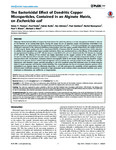The Bactericidal Effect of Dendritic Copper Microparticles, Contained in an Alginate Matrix, on Escherichia coli
| dc.contributor.author | Thomas, SF | |
| dc.contributor.author | Rooks, P | |
| dc.contributor.author | Rudin, F | |
| dc.contributor.author | Atkinson, S | |
| dc.contributor.author | Goddard, P | |
| dc.contributor.author | Bransgrove, R | |
| dc.contributor.author | Mason, PT | |
| dc.contributor.author | Allen, MJ | |
| dc.date.accessioned | 2017-05-10T13:37:39Z | |
| dc.date.available | 2017-05-10T13:37:39Z | |
| dc.date.issued | 2014 | |
| dc.identifier.issn | 1932-6203 | |
| dc.identifier.issn | 1932-6203 | |
| dc.identifier.other | ARTN e96225 | |
| dc.identifier.uri | http://hdl.handle.net/10026.1/9218 | |
| dc.description.abstract |
Although the bactericidal effect of copper has been known for centuries, there is a current resurgence of interest in the use of this element as an antimicrobial agent. During this study the use of dendritic copper microparticles embedded in an alginate matrix as a rapid method for the deactivation of Escherichia coli ATCC 11775 was investigated. The copper/alginate produced a decrease in the minimum inhibitory concentration from free copper powder dispersed in the media from 0.25 to 0.065 mg/ml. Beads loaded with 4% Cu deactivated 99.97% of bacteria after 90 minutes, compared to a 44.2% reduction in viability in the equivalent free copper powder treatment. There was no observed loss in the efficacy of this method with increasing bacterial loading up to 10(6) cells/ml, however only 88.2% of E. coli were deactivated after 90 minutes at a loading of 10(8) cells/ml. The efficacy of this method was highly dependent on the oxygen content of the media, with a 4.01% increase in viable bacteria observed under anoxic conditions compared to a >99% reduction in bacterial viability in oxygen tensions above 50% of saturation. Scanning electron micrographs (SEM) of the beads indicated that the dendritic copper particles sit as discrete clusters within a layered alginate matrix, and that the external surface of the beads has a scale-like appearance with dendritic copper particles extruding. E. coli cells visualised using SEM indicated a loss of cellular integrity upon Cu bead treatment with obvious visible blebbing. This study indicates the use of microscale dendritic particles of Cu embedded in an alginate matrix to effectively deactivate E. coli cells and opens the possibility of their application within effective water treatment processes, especially in high particulate waste streams where conventional methods, such as UV treatment or chlorination, are ineffective or inappropriate. | |
| dc.format.extent | e96225-e96225 | |
| dc.format.medium | Electronic-eCollection | |
| dc.language | en | |
| dc.language.iso | eng | |
| dc.publisher | Public Library of Science (PLoS) | |
| dc.subject | Alginates | |
| dc.subject | Anti-Bacterial Agents | |
| dc.subject | Copper | |
| dc.subject | Escherichia coli | |
| dc.subject | Hypoxia | |
| dc.subject | Microbial Sensitivity Tests | |
| dc.subject | Microbial Viability | |
| dc.subject | Microscopy, Electron, Scanning | |
| dc.subject | Microspheres | |
| dc.subject | Oxygen | |
| dc.subject | Water Microbiology | |
| dc.subject | Water Pollutants | |
| dc.subject | Water Purification | |
| dc.title | The Bactericidal Effect of Dendritic Copper Microparticles, Contained in an Alginate Matrix, on Escherichia coli | |
| dc.type | journal-article | |
| dc.type | Article | |
| plymouth.author-url | https://www.ncbi.nlm.nih.gov/pubmed/24831035 | |
| plymouth.issue | 5 | |
| plymouth.volume | 9 | |
| plymouth.publication-status | Published online | |
| plymouth.journal | PLoS ONE | |
| dc.identifier.doi | 10.1371/journal.pone.0096225 | |
| plymouth.organisational-group | /Plymouth | |
| plymouth.organisational-group | /Plymouth/Faculty of Science and Engineering | |
| dc.publisher.place | United States | |
| dcterms.dateAccepted | 2014-04-04 | |
| dc.identifier.eissn | 1932-6203 | |
| dc.rights.embargoperiod | Not known | |
| rioxxterms.versionofrecord | 10.1371/journal.pone.0096225 | |
| rioxxterms.licenseref.uri | http://www.rioxx.net/licenses/all-rights-reserved | |
| rioxxterms.licenseref.startdate | 2014 | |
| rioxxterms.type | Journal Article/Review |


